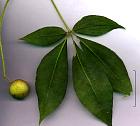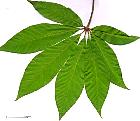Other chestnut trees
|
||||||||||||||||||||||
| Difference | Horsechestnut | Aesculus flava | A. glabra |
|---|---|---|---|
| Size | 25 m | 25 m | 20 m |
| Bark | reddish-brown - ruddy which exfoliate into flakes | dark-haired woman clipped by rhombs. |
harsh |
| Leaflets | narrow, sharpened, petiolate | ||
| Flowers | white | yellow, in 15 cm bunch | yellow, in 18 cm spike |
 Red Buckeye, Aesculus Pavia
Red Buckeye, Aesculus Pavia
Etymology: named in honor of Peter Paaw (died in 1619).
Origin: Southeast of the United States. It was the first Aesculus of North America to be described, in 1696 (Plukenet).
Bush size (6 m) unlike other chestnut trees.
Webbed leaves with 5 leaflets from 8 to 14 cm in length. Each is oblong or elliptical, doubly toothed, beardless, dark green over, paler underside and pubescent in the axil of ribs. Leaflets are embossed and carry a petiole which differentiates them of leaflets of chestnut tree of India.
Flowers of cream or yellow colour, sometimes pink or red. They appear in May, June. Stamens are the same length as the petals.
Fruits: small, protruding, unarmed.
Aesculus pavia var. flavescens has yellow flowers. The stamen is shorter.
Red chestnut tree, Aesculus x carnea
Hybrid of crossing (chestnut tree of India x pavia)
Lifespan: 150 years.
Habitat: the red Chestnut tree prefers sunny position or half shade. It must be watered at dry period.
Height: 25 m tall.
Trunk: robust, right.
Shape: ovoid or rounded crown.
Blackish bark, gerçurée, scaly.
Foliage: big leaves (but smaller than those of the chestnut tree of India), precocious, formed by 5 or 7 leaflets obovate, erratically toothed, the terminal being bigger than others, of a nice green, glabrous, with brown hair on the underside, along ribs.
Flowers: in upright thyrses, appearing in May, of red colour.
Fruits: Rare Fruits, sun-tanned rufous, prickly sparsely.
Use: trees very decorative.
Cultivar: ' Briotii'
It was obtained from nurseries Trianon at Versailles in 1858.
The inflorescences are larger, darker flowers, red blood.
It does not bear fruit.
Chestnut tree of the Himalayas,
white flowers and petiolate leaflets.


|
|
|
|
Copyright© 2000 · 2024